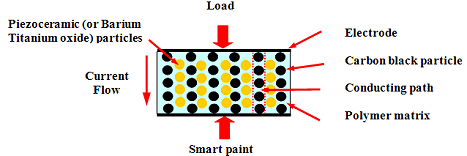|
Smart Paint Project
(Sponsor: King Saud University)
The main objective of the proposed study is to develop a new class of smart paints whereby the epoxy resin will be mixed with carbon black nanoparticles to make it electrically conducting. The developed paint can then be applied to the structures using conventional spray guns. A one-layer of specially patterned electrodes will be bonded to the structures, prior to spraying the paint, in order to monitor the changes in the electrical resistance of the paint, at critical discrete locations, when it is subjected to external vibration or acoustic excitations.
The main approach adopted in this study is to mix inherently insulating polymers with electrically conducting fillers, such as carbon black particles in order to make the polymer conductive. The electric conduction mechanism is attributed to percolation and tunneling effect as shown in the figure below.
 
(a) Sensor |
(b) Resistivity |
Conducting Polymer Sensor |
When subjected to tensile loading, the separation between adjacent filler particles increases causing the electrical resistivity to increase and upon the application of compressive loading, the reverse occurs. In this manner, strain sensing can be achieved. The sensitivity of the sensor to the applied strain depends on various factors including the type of polymer matrix, conductive filler, filler loading, and/or degree of strain. In this proposal, we will capitalize on the fact that the performance of the conducting polymer can be dramatically improved by adding piezoceramic (or barium titanium oxide) particles as can be seen from the figure below.
 
Effect of volume fraction of barium titanium oxide (BaTiO3) on percolation threshold and resistivity |
Specifically, the above figure indicates that the percolation threshold decreases and the conductivity increases with increased volume fraction of barium titanium oxide. With such improved conductivity characteristics, the smart paint sensor is envisioned to have the potential for exhibiting excellent performance when optimal volume fraction of carbon black and piezoceramic (or barium titanium oxide) particles are added (as shown below). The effect of the volume fraction of the ingredients on the dynamic behavior of the sensor remains an issue to be addressed in this proposed study.

To facilitate modeling formulation, the real microstructure of the sensor is simplified as illustrated in the figure below.

The resistance (Ra) is the overall carbon black aggregates resistance of the composite. The gaps between the carbon black aggregates are equivalent to resistor–capacitor elements. These parallel elements (Rg) and (Cg) are the overall gaps resistance and capacitance of the composite respectively. The (Ra), (Rg) and (Cg) components are considered ideal, that is frequency independent, and are estimated from the impedance spectrum of the sensor.
Comparisons between the theoretical predictions and the experimental results of the sensor real and imaginary impedances of the sensor are presented in the figure below.

Real Z’ and imaginary Z” impedance spectrum |
The figure below shows photographs of the sensor and its testing set-up.


Predicted and experimental voltage drop in the sensor |
 Science Direct Top 25 Hottest ArticlesCategory: Sensors & ActuatorsJanuary to March 2009 Science Direct Top 25 Hottest ArticlesCategory: Sensors & ActuatorsJanuary to March 2009
“Nanocomposite Functional Paint for Vibration and Noise Monitoring” [Link to Award] - [Paper in PDF]
|
Aldraihem O., A. Baz, and T. Al-Saud, “Hybrid Composites with Shunted Piezoelectric Particles for Vibration Damping”, Journal of Mechanics of Advanced Materials and Structures, Vol. 14, pp: 413–426, 2007.
Aldraihem O., W. Akl, and A. Baz, “Nanocomposite Functional Paint for Vibration and Noise Monitoring”, Journal of Sensors and Actuators A: Physical, Vol. 149, pp. 233–240, 2009.
Al-Saffar Y., O. Aldraihem, and A. Baz, ”Smart Paint Sensor for Monitoring Structural Vibrations”, Paper # SMASIS 2010-3878, ASME Smart Materials, Adaptive Structures, & Intelligent Systems, Philadelphia, Sept. 28-Oct 1, 2010.
Top of Page
|

